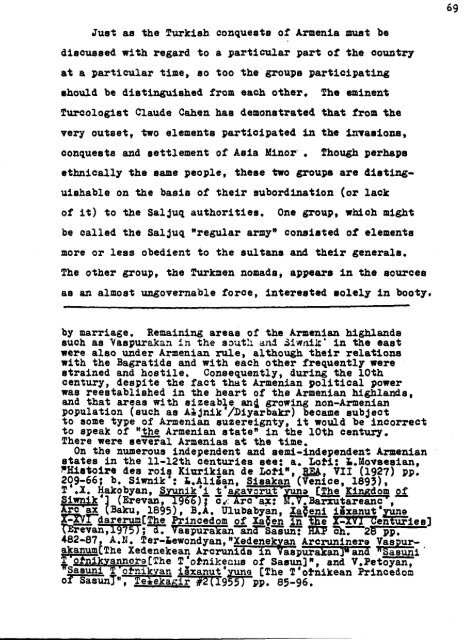The Turco-Mongol Invasions and the Lords of Armenia in the 13 ...
The Turco-Mongol Invasions and the Lords of Armenia in the 13 ...
The Turco-Mongol Invasions and the Lords of Armenia in the 13 ...
Create successful ePaper yourself
Turn your PDF publications into a flip-book with our unique Google optimized e-Paper software.
Just as <strong>the</strong> Turkish conquests <strong>of</strong> <strong>Armenia</strong> oust be<br />
discussed with regard to a particular part <strong>of</strong> <strong>the</strong> country<br />
at a particular time, so too <strong>the</strong> groups participat<strong>in</strong>g<br />
should be dist<strong>in</strong>guished from each o<strong>the</strong>r. She em<strong>in</strong>ent<br />
<strong>Turco</strong>logist Claude Cahen has demonstrated that from <strong>the</strong><br />
very outset, two elements participated <strong>in</strong> <strong>the</strong> <strong>in</strong>vasions,<br />
conquests <strong>and</strong> settlement <strong>of</strong> Asia M<strong>in</strong>or . Though perhaps<br />
ethnically <strong>the</strong> same people, <strong>the</strong>se two groups are dist<strong>in</strong>g-<br />
uishable on <strong>the</strong> basis <strong>of</strong> <strong>the</strong>ir subord<strong>in</strong>ation (or lack<br />
<strong>of</strong> it) to <strong>the</strong> Saljuq authorities. One group, which might<br />
be called <strong>the</strong> Saljuq "regular army" consisted <strong>of</strong> elements<br />
more or less obedient to <strong>the</strong> sultans <strong>and</strong> <strong>the</strong>ir generals.<br />
<strong>The</strong> o<strong>the</strong>r group, <strong>the</strong> Turkmen nomads, appears <strong>in</strong> <strong>the</strong> sources<br />
as an almost ungovernable force, Interested solely <strong>in</strong> booty.<br />
by marriage. Rema<strong>in</strong><strong>in</strong>g areas <strong>of</strong> <strong>the</strong> <strong>Armenia</strong>n highl<strong>and</strong>s<br />
such as Yaspurakan <strong>in</strong> <strong>the</strong> south <strong>and</strong> Sivmii:' <strong>in</strong> <strong>the</strong> east<br />
were also under <strong>Armenia</strong>n rule, although <strong>the</strong>ir relations<br />
with <strong>the</strong> Bagratids <strong>and</strong> with each o<strong>the</strong>r frequently were<br />
stra<strong>in</strong>ed <strong>and</strong> hostile. Consequently, dur<strong>in</strong>g <strong>the</strong> 10th<br />
century, despite <strong>the</strong> fact that <strong>Armenia</strong>n political power<br />
was reestablished <strong>in</strong> <strong>the</strong> heart <strong>of</strong> <strong>the</strong> <strong>Armenia</strong>n highl<strong>and</strong>s,<br />
<strong>and</strong> that areas with sizeable <strong>and</strong>. grow<strong>in</strong>g non-<strong>Armenia</strong>n<br />
population (such as Aljnik'/Diyarbakr) became subject<br />
to some type <strong>of</strong> <strong>Armenia</strong>n suzereignty, it would be <strong>in</strong>correct<br />
to speak <strong>of</strong> "<strong>the</strong> <strong>Armenia</strong>n state" <strong>in</strong> <strong>the</strong> 10th century.<br />
<strong>The</strong>re were several <strong>Armenia</strong>s at <strong>the</strong> time.<br />
On <strong>the</strong> numerous <strong>in</strong>dependent <strong>and</strong> semi-<strong>in</strong>dependent <strong>Armenia</strong>n<br />
states <strong>in</strong> <strong>the</strong> ll-12th centuries see; a. Lori: l.Movsesian,<br />
FHietoire des rois Kiurikian de Loti", 8SA, VII (1927) pp.<br />
209-66; b. Siwnik': t.Alisan, Sisakan (Venice, 1893),<br />
T .X. Hakobyan, gyunik'i t'agavorut"yuna [<strong>The</strong> K<strong>in</strong>gdom <strong>of</strong><br />
Siwnik'] (Erevan, 1966)7 c".-: Arc -ax: lOTBarrutareanc',<br />
Arc-ax (Baku, 1895), B.A. Ulubabyan, Xa$eni iixanut'yuna<br />
X-TVidarerunC<strong>The</strong> Pr<strong>in</strong>cedom <strong>of</strong> Xa?en Tn T<strong>in</strong>e X-XVI Centuries]<br />
TBrevan,1975); oV Vaepurakan ancTSasun: HAT ch~28 pp.<br />
482-87, A.M. Ier-£ewondyan."Xedenekyan Arerun<strong>in</strong>era Yaspurakanumt<strong>The</strong><br />
Xedenekean Arcrunids <strong>in</strong> VaspurakanJ"<strong>and</strong> ^Sasuni<br />
T &fnikvannera T<strong>The</strong> T'otnikeaiis <strong>of</strong> Sasun]", <strong>and</strong> V.Petoyan,<br />
"Sasuni I'ornikyan iBxanut'yuno [<strong>The</strong> T'ornikean Pr<strong>in</strong>cedom<br />
<strong>of</strong> SasunT". Teiekaeir #2(1955T"DD. 85-96.<br />
69

















